Japan Wood Products
Prices
Dollar Exchange Rates of
10th November 2014
Japan Yen 114.86
Reports From Japan
Consumption tax increase postponed
The latest consumer confidence survey released by Japan‟s
Cabinet Office shows the October index falling for a third
straight month.
The overall Sentiment Index for households, which
combines attitudes towards job and prospects for income
growth, also fell in October to the lowest reading since
April this year.
The weak data has resulted in the government deciding to
postpone, for 18 months, the planned additional tax
increase which would have brought the consumption tax to
10% in April 2015.
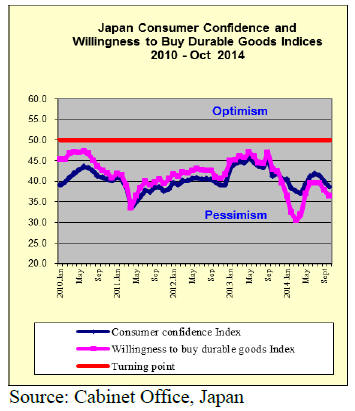
Trade deficit with China increases by 37 percent.
The trade between Japan and China in the first half of
2014 increased by 4.4% to US$168.4 billion, an increase
from the double-digit declines seen in the same period in
2013.
However, the total level of trade was not as high as in the
first half of 2012. Japan‟s exports to China in the first half
of this year increased by 2.5% to US$78 billion and
imports from China rose by 6.1% to US$90.4 billion.
While imports are recovering to almost the same level as
those of the first half of 2012, the recovery of exports is
sluggish which led to a record deficit of US$12.3 billion,
up over 37% from the first half of 2013.
China‟s share of Japan‟s total international trade in the
first half of 2014 remained much as in 2013 at around
20%. Amongst Japan‟s global trade partners, China
regained its number one trade partner ranking having
slipped into second place in 2013.
For more see:
https://www.jetro.go.jp/en/news/releases/20140822008-
news
Business sentiment indicator remains firm
Orders for new machinery by Japanese manufacturers, a
key indicator of private sector capital expenditure and a
reflection of business sentiment, rose by almost 3% in
September. This was the fourth consecutive monthly
increase but the pace of increase slowed in September.
According to a Cabinet Office survey, the value of
machinery orders received by 280 manufacturers operating
in Japan, including orders from domestic and international
companies, increased by 8.0% in September from the
previous month. For more see:
http://www.esri.cao.go.jp/en/stat/juchu/1409juchu-e.html
Private-sector machinery orders, excluding those for ships
and those from power companies, increased a seasonally
adjusted by 2.9% in September, and showed increase by
5.6% in July-September period. In the October-December
period machinery orders are forecast to increase by 9%.
Yen slips to 115 to the dollar, exporters cheer
In response to the surprise announcement from the Bank
of Japan (BoJ) that it would expand its monetary easing
the yen fell sharply lower against the dollar and other
major currencies in mid-November.
Just after the BoJ statement the dollar was at 113.85 to the
yen close to the 114 seen as far back at 2007. Since the
announcement from the Bank the yen has continued to
weaken and on 10 November was at 115.40 to the US
dollar.
While Japanese exporters will benefit from the weaker yen
the impact on the trade deficit will be serious given the
high fuel import bill. Renewed yen weakness prompted
many Japanese exporters to reassess upwards their profit
outlook for the year to end March.
However, smaller companies that rely on imported raw
materials will now find business conditions even tougher.
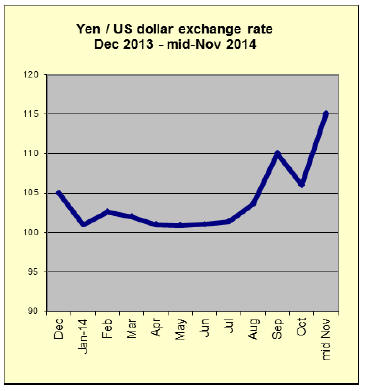
Government to consider quick action to revive home
sales
In the period April to September (i.e. first half of fiscal
2014) housing starts reported by the Ministry of Land,
Infrastructure, Transport and Tourism were down almost
12% from the same period a year earlier.
This has prompted the government to consider quick
action to revive home sales and, through this, the prospects
for the construction and building supply sectors which are
major employers.
To stimulate the housing market two actions are being
considered, bringing back the eco-point system and cutting
interest rates on fixed rate mortgages.
Under the Eco-points programme those building new
houses that meet energy-saving standards (or those
renovating homes for energy saving) earn points which
can be exchanged for consumer goods. It is likely that
these issues will be included in the ruling party‟s
manifesto as it prepares for a snap election.
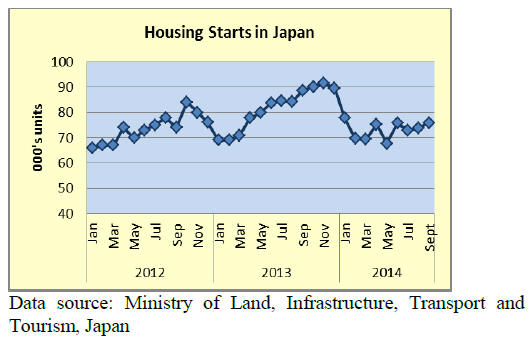
Trends in office, kitchen and bedroom furniture
imports
Japan‟s office, kitchen and bedroom furniture imports
from 2009 to the end of September 2014 are shown below.
The weakening of furniture imports reinforces the view
that consumer sentiment is negative and that the economy
is yet to recover from the consumption tax increase in
April.
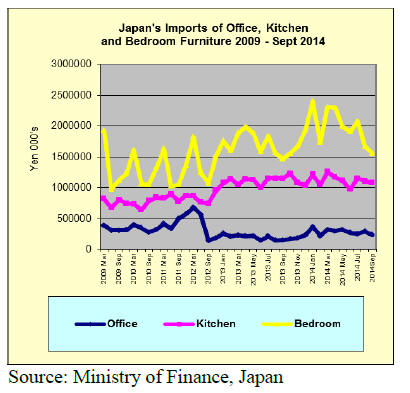
Households cut back on buying furniture
Between January and September Japanese households
have reigned in personal consumption. The latest Family
Income and Expenditure Survey reported by Japan‟s
Statistics Bureau shows average monthly income per
household stood at yen 421,809, down 6.0% in real terms
from the previous year.
Surprisingly, expenditure on education was sharply down
mainly as families cut back their children‟s extracurricular
activities. Expenditure on furniture was also
down over 10%.
See more at:
http://www.stat.go.jp/english/data/kakei/156.htm
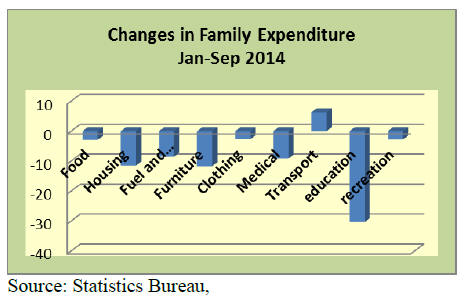
Trade news from the Japan Lumber Reports (JLR)
The Japan Lumber Reports (JLR), a subscription trade
journal published every two weeks in English, is
generously allowing the ITTO Tropical Timber Market
Report to extract and reproduce news on the Japanese
market.
For the JLR report please see:
http://www.n-mokuzai.com/modules/general/index.ph
p?id=7
JLR text -
SGEC prepares mutual recognition with PEFC
SGEC (Sustainable Green Ecosystem Council) is the
original forest certification system of Japan. It has been
preparing to have mutual recognition with PEFC (Program
for the Endorsement of Forest Certification Schemes), the
world largest forest certification system.
SGEC has been making revised plan of SGEC‟s
management and administration system and guideline for
certification, which are necessary for mutual recognition.
On October 16, it disclosed the content for public
comment for 60 days. After this period, SGEC will apply
for admission and hopes to start mutual recognition in
2016.
PEFC‟s chairmen will visit Tokyo in this month and will
hold the forum to commemorate SEGC‟s participation to
PEFC.
PEFC approved forest certification system of the U.S.A.,
Canada and Russia. In Asia, Malaysia has already done
mutual approval with PEFC then China started in January
this year.
Indonesia will be approved in November. SGEC joined
PEFC in last June as the first step for mutual recognition.
SGEC started in 2003 so it has built up enough base for
the system.
Ranking of wood based house builders
In 2013, housing companies enjoyed expanded demand
before the consumption tax increase. In 2014, new
housing starts are dropping and house builders are
aggressively developing renovation orders of used houses
and orders of non-residential buildings and rental multifamily
units.
Hajime Kensetsu is the top builder with 11,265 with
45.8% growth then Sekisui House built 5,066 units, 19.8%
increase. Its model of Shawood has high reputation. Touei
Housing had 4,329, 10.3% increase.
For wood based units built for sale and multi dwelling
complex like apartment, Hajime Kensetsu, Touei Housing
and Polus Group had large growth while Iida Home and
Tact Home declined in number.
August plywood supply
The demand has been dull and slow after May but the
manufacturers adamantly stuck to firm prices by
production curtailment so that the market had been
holding steady through September.
In demand slow market, small manufacturers started
selling with lower prices, which results in difference of
on-hand inventories. Large manufacturers‟ inventories are
getting close to one month so they are not able to hold up
any longer and started accepting lower offers.
Total plywood supply in August was 460,300 cbms,
10.7% less than August last year and 11.6% less than July,
which is the lowest monthly supply since October 2011.
In particular, imported plywood decreased by about 40 M
cbms compared to July and production curtailment by
domestic plywood plants also influenced total supply.
Total imports in August are 247,300 cbms, 13.4% less and
15% less. This is fourth straight months decline and the
lowest level in three years. Average monthly arrivals for
the first eight months are 302,200 cbms, 3.5% less than the
same period of last year.
Malaysian supply had declined for four straight months
and the August arrivals of 98,700 cbms are the lowest
monthly arrivals in this year. This is the lowest since
October 2011.Monthly average supply for the first eight
months is 126,500 cbms, 10.2% less than the same period
of last year.
Indonesian supply also dropped by about 20 M cbms from
July. 74,100 cbms are the lowest since September 2012
and this is 18.8% less than August last year and 20.7% less
than July. Eight month average is 88,800 cbms, 1.5% less
than the same period of last year.
China‟s supply of 54,700 cbms was 15.7% less and 14.8%
less. Monthly average for eight months is 66,300 cbms,
1.2% less than the same period of last year.
The supply by three major sources for the first eight
months is 5.5% less than last year. The importers estimate
arrivals in September and October would be about 260-
270,000 cbms.
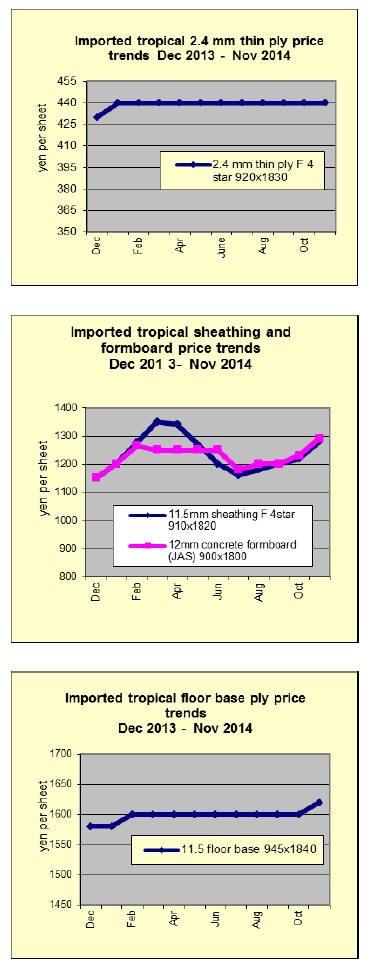
South Sea (tropical) hardwood plywood market
Import volume of South Sea hardwood plywood seems to
stay low though the year and the market finally shows sign
of recovery in small degree.
Because of continuous increase of export prices by the
suppliers, future purchases are limited. August arrivals
were less than 250,000 cbms, the lowest in three years out
of which Malaysian supply was less than 100,000 cbms.
Future contracts dropped considerably after June because
of the gap between suppliers‟ export prices and depressed
Japan market prices.
The market prices plunged since last May by dumping of
the some importers then finally bottomed out in late June.
The gap widened so that importers hardly commit future
purchase in June through August without hope of market
recovery.
ince late August the yen has started dropping against US
dollar so the situation got further difficult.
As a result of decline of future purchase, import volume
after September will be down to 260-270,000 cbms a
month. October offers by the suppliers are US$5-01 up
from September. Arrival cost of JAS 3x6 concrete forming
panel for coating would cost over 1,400 yen per sheet FOB
truck while the market prices now are 1,350 yen per sheet
delivered.
Although the prices are up by 20 yen per sheet compared
to September, they are far from suppliers‟ offer prices.
The supplies say to increase the offer prices further toward
December so future purchase is getting more difficult.
|